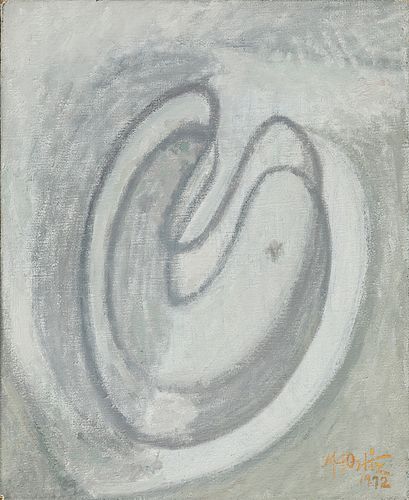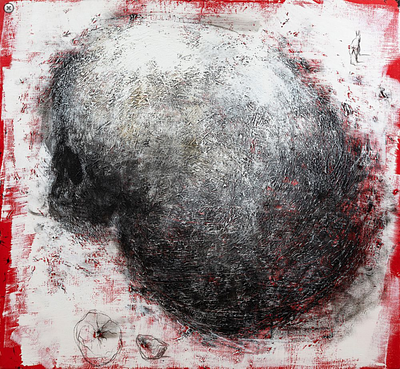MANUEL ANGELES ORTIZ (Jaén, 1895 - Paris, 1984). "Sculpture", 1972. Oil on canvas.
Lot 65
About Seller
Setdart Auction House
Carrer Aragó 346
Barcelona
Spain
Setdart Subastas was born in 2004 and is currently the first online art auction in Spain with solidity, prestige and reliability guaranteed by our more than 60,000 users. Setdart has a young, dynamic and enterprising team ready to successfully manage the purchase and sale of art works through custom...Read more
Estimate:
EUR€6,000 - EUR€7,000
$6,315.79 - $7,368.42
Absentee vs Live bid
Two ways to bid:
- Leave a max absentee bid and the platform will bid on your behalf up to your maximum bid during the live auction.
- Bid live during the auction and your bids will be submitted real-time to the auctioneer.
Bid Increments
| Price | Bid Increment |
|---|---|
| EUR€0 | EUR€10 |
| EUR€200 | EUR€25 |
| EUR€500 | EUR€50 |
| EUR€1,000 | EUR€100 |
| EUR€3,000 | EUR€200 |
| EUR€5,000 | EUR€500 |
| EUR€10,000 | EUR€1,000 |
| EUR€20,000 | EUR€2,000 |
| EUR€50,000 | EUR€5,000 |
About Auction
By Setdart Auction House
Oct 19, 2021
Set Reminder
2021-10-19 08:00:00
2021-10-19 08:00:00
America/New_York
Bidsquare
Bidsquare : CONTEMPORARY ART
https://www.bidsquare.com/auctions/setdart-auction-house/contemporary-art-7701
Setdart Auction House sofia@setdart.com
Setdart Auction House sofia@setdart.com
- Lot Description
MANUEL ANGELES ORTIZ (Jaén, 1895 - Paris, 1984). "Sculpture", 1972. Oil on canvas. Signed and dated in the lower right corner. Titled on the back. Measurements: 46 x 38 cm; 58 x 50 cm (frame). In the exhibition dedicated by the Museo y Centro de Arte Reina Sofía in Madrid, it was pointed out that the work of Manuel Ángeles Ortiz is difficult to classify. This difficulty is appreciated even in this work, where the artist makes a game through the title and the support, thus inviting the viewer to reflect on the work. This same reflection is what he transferred to all his artistic work, for this reason it is difficult to classify it as part of a movement, or a specific aesthetic. During the 60's he created his work geometric head, he was interested in the human figure and compositional analysis. In this work you can appreciate these interests, but at the same time a surrealist heritage. The work of Manuel Ángeles Ortiz shows the same alternation of languages (late Cubism, line drawing and round and monumental volumes of classical inspiration, etc.), a symptom of the different approaches to a return to order, promulgated by different voices, from Cahiers d'Art to Jean Cocteau or Amédée Ozenfant. He was an independent artist, difficult to classify stylistically, as he did not stop experimenting throughout his career, although he rejected abstract painting. That is why he is attracted to surrealism for "its enigmatic lyricism, not its morbid aberrations of psychotic subjection", as he himself points out. Manuel Ángeles Ortiz was an essential artist in the renewal of art in Spain throughout the 1920s and until the Civil War in Spain. Representative of the Spanish School of Paris, Manuel Ángeles Ortiz began his training in Granada, in the studio of José Larrocha. He later completed his studies at the Escuela Superior de Artes Industriales in the city, and then moved to Madrid, where he continued his training in the studio of Cecilio Plá. In 1915 he made his debut in a collective exhibition, receiving very good reviews in the local press. At the beginning of the twenties he moves to Paris, where he will have in Picasso his main support and first enthusiast. There he had his first individual exhibition, held at the Quatre Chemins gallery in 1926. In 1932 he returned to Spain, but his anti-fascist stance led him to go first to Paris and then to Buenos Aires, where he became fully integrated in the artistic environment and lived until 1948, when he returned to Paris for good. From his first stay in Paris, Pablo Picasso's imprint on his work is profound. The same happens in Buenos Aires, his series of woods are not found objects, but pieces worked following his own intuitions. All this is linked to the tradition of the poetics of the primitive, developed by artists such as Benjamin Palencia, Angel Ferrant, or Alberto Sanchez, but also by Paul Klee, Jean Arp and Constantin Brancusi. From the fifties in his work persist the landscape and the human figure but approaches informalism. He is currently represented in the Reina Sofía National Museum in Madrid, the ARTIUM in Vitoria, the Patio Herreriano in Valladolid, the Contemporary Art Museum in Seville, the Fine Arts Museum in Grenoble, the Federico García Lorca, Mapfre and Telefónica Foundations and the Bargera Gallery in Cologne, among other public and private collections.
- Shipping Info
-
In-house shipping available. Please inquire at admin@setdart.com.
-
- Buyer's Premium



 EUR
EUR CAD
CAD AUD
AUD GBP
GBP MXN
MXN HKD
HKD CNY
CNY MYR
MYR SEK
SEK SGD
SGD CHF
CHF THB
THB

















